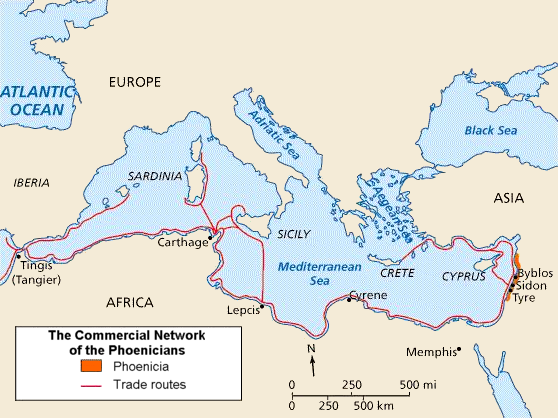
This creative and entrepreneuring people ventured through the Mediterranean and beyond, establishing trading outposts as they navigated from one land to another.
Carthage was one such city state founded by the Phoenicians in modern day Tunisia which would eventually become one of the most prominent cities of its time.

The Phoenicians first came to Malta in around 700BC incorporating the islands into their trading network until the Roman invasion of 218BC.
As trade increased, the need for expansion brought about a growing number of settlements distributed around the islands. This included settling down at some of the strongholds of the previous Bronze Age cultures.
Despite a phase that lasted for some 500 years and a cultural legacy that went even beyond that span, very little has survived in terms of their buildings and structures.
Their presence is amply evidenced however by several burial sites and tombs, with the vast majority being found in the Rabat area, this having been the main settlement on the islands.
But smaller clusters and individual tombs have been documented in at least another 40 localities.
According to "The Punic Tombs of the Maltese Islands", by historian George A. Said-Zammit' 649 tombs had been discovered in Malta up till then. (1993) - (2)
Said-Zammit lists 25 Punic tombs in Mosta, 1 in Burmarrad and another 33 in neighbouring Mgarr.
The high ridge resulting from great natural fault and surrounding hills mainly around Mosta's northern side were considered as suitable sites for settlements from many eras, both before and after the Punic era.
It is no surprise that fewer Punic tombs have been found in this area, but the same cannot be said for the higher ground, including the hills of Bidnija and Wardija.
(Pron. in English as Tull, as in hull & Way)
Comprising a sacred burial ground, it consists of a network of rock pools and ancient tombs, and is considered by experts to date back to the Bronze Age.
Fellow NGO, Grupp Arkeologiku Malti (GAM), has conducted a number of studies in order to reconstruct this expansion by a re-examination of the phoenician tombs found in the Maltese Islands. This is what they have to say about such tombs:
A shaft, usually square but occasionally round in shape, opens at its base to one or more chambers. When the height of the shaft exceeds 1m a number of steps or footholds are usually found making the descent easier. The entrance to the chamber is often worked to receive a closing slab stone.

leading to two side-chambers
The tomb was subsequently closed and the shaft filled by small stones.
The first is the rock-cut grave pit, the other in a soil depression.
As one can see in the photos above, the rock-hewn type consisted of a rectangular shaft with chambers dug into one of more sides. The shaft would then be covered by large slabs. Earlier examples have shafts that are square rather than rectangular in shape.
Changing influences along with other factors such as practicality and expense, led to various burial methods:
embalming, interment and cremation.
The first was reserved for royalty and no such tombs have been documented locally. Inhumations were the most popular method but cremation was not uncommon either.
The ashes were deposited in a special burial urn which was then placed in the grave.
The belief in an afterlife, the soul crossing over water, items left in tombs to facilitate the journey and start of a new life all co-exist in both cultures.
Several findings in Maltese tombs, such as amulets and talismans, hence depict Egyptian deities such as Isis and Horus.
Punic amulets devoted to Horus & Anubis (6)
Apart from a large number of Punic tombs situated on the hillocks of Wardija and Bidnija, several more have been discovered in the valleys enclosing the promontory at ix-Xaghra ta' Tomba and the surrounding areas including at l-Imselliet, Xaghriet ta' Frasku, South of Dar il-Hamra, Wied ta' Sejkla, Tat-Tiniet, Falka Ridge, Busbezija, Taz-Zejfi, l-Imghanxaq, Hodba tal-Modd, tal-Qares and around Tal-Bistra.
Tomb clusters were documented at Sta. Margerita, ta' Vnezja and Tas-Saghat, while smaller numbers are to be found at Wied l-Isperanza and other areas such as Tad-Dipp, Misrah Ghonoq & Sqaq Redusa.
The majority of Punic tombs found in the Mosta area show evidence of re-use over time by people of the same culture, suggesting that these settlements lasted for several generations over a span of centuries.
The table below attempts to list the tombs chronologically based on shape / design, contents and other supporting evidence gathered from their respective locations.
It is only to be considered as a guideline, and is surely incomplete. (7)
Greyscale photo - St. Agatha's Catacombs (Museum), Rabat / G.A. Said-Zammit
Coloured photo - St. Paul's Catacombs, Rabat / Mikestravelguide.com
Gold amulet Photo - Recovered from Punic Tomb at Ghajn il-Klieb, l/o Rabat, / Tripadvisor
Horus amulet photo - Unknown / Charles Savona-Ventura
(Punic Mythology & Medicine, Pg.84)
7. Table compiled from data in study by historian Anton Bugeja titled:
"Archaeological sites around Tal-Bistra"